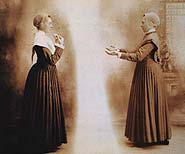In the 19th century, Sunday visitors to Shaker communities often came to observe Shaker worship. James Fenimore Cooper, only one in a long line of “celebrities” that visited the Shakers, recorded his observations on Shaker worship in The travelling bachelor, or Notions of the Americans: “At the commencement of the song, the dancers moved forward, in a body, about three feet each, turned, shuffled, and kept repeating the same evolutions the whole time of this remarkable service. It is scarcely possible to conceive anything more ludicrous, and yet more lamentable. I felt disposed to laugh, and yet I could scarcely restrain my tears. I think, after the surprise of the ludicrous had subsided, that the sight of so much miserable infatuation left a deep and melancholy regret on my mind.”
Among many other things, the Shakers were known for their dancing, or “laboring.” The earlier modes of worship did not include any sort of standardized or choreographed movements, and people referred to them as “Shaking Quakers” – later shortened to “Shakers” – a derogatory term that the Shakers eventually adopted for their own use. It wasn’t until the late 18th century under Mother Lucy Wright’s ministry that dance became standardized and practiced. Between 1787 and 1797, the Shakers created seven forms of Shaker dance; the “Holy Order” and the “Regular Step” remained the main dances for the next two decades.
The 1820s brought a new decade of innovations in which the Shakers created the Round, the Hollow Square, and Square Step dances and the Circular, Square, and Compound marches. These new dances differed from those developed in the 1790s in a number of ways. Words were introduced to laboring songs in 1811 with the introduction of the Quick Dance. Other songs did not have lyrics but included vocalized version of secular fiddle songs. The Quick Dance also used a circle formation; earlier Meeting Houses did not have enough space to use circles and were the reason that the early dances used only narrow movements. The dance developments of the 1820s also included marching, which was given to the Shakers as a vision gift. This was beneficial for the first converts, who were growing older and weren’t able to move as they used to. Shaker marching is done with a “bounding, elastic step,” unlike the way soldiers march. Marching allowed for variation in age groups as well as regional differences, and could include hand movements and clapping.
Shaker dance is very obviously different than secular folk dance. The laboring dances were planned and practiced meticulously by the Shakers, unlike secular dances, which used a caller to indicate the next steps. There are no dance partners, which is a reflection of their celibate lifestyle. Religious symbolism was introduced to dances in the 1820s. Earlier dances were used to cast off feelings of lust or express joy and represented unity, purity, and labor. It was Mother Lucy who, in 1815, suggested gestures to accompany particular lyrics. The primary gesture use was a “shaking off of sins:” Believers beat time with their forearms parallel to the floor, palms facing down.
Like Cooper and other authors, many artists, dancers, choreographers, and musicians were and continue to be inspired by the Shakers. The 20th century dancer and choreographer Dorothy Humphrey created a piece called “The Shakers” (1930). The piece is a product of her own fascination with the Shakers and her interest in formal dance. The dance was inspired by authentic Shaker hymns and dances.
On April 14th at 1pm, the Nacre Dance Company will be performing “The Shakers” in our 1848 Meeting House. There is a suggested donation of $5 per adult. For more information about the Nacre Dance Company, please visit nacredance.com or call (518) 435-0510. We hope you’ll join us for what is sure to be a wonderful performance!


